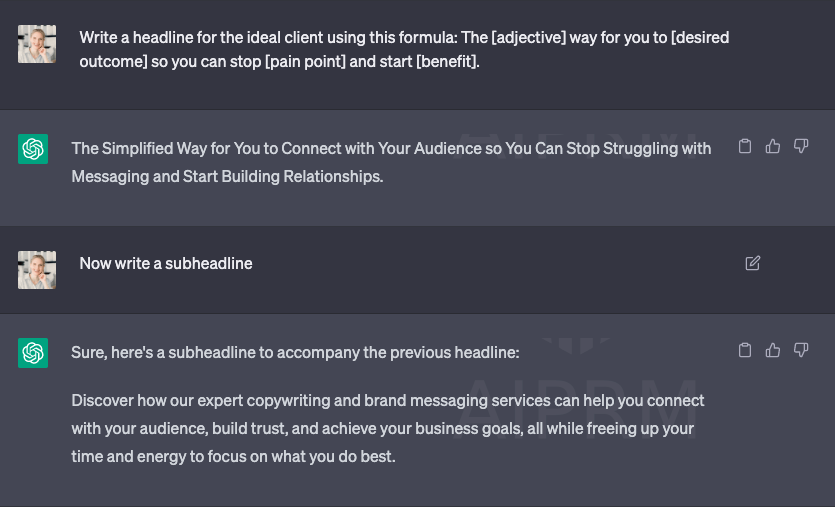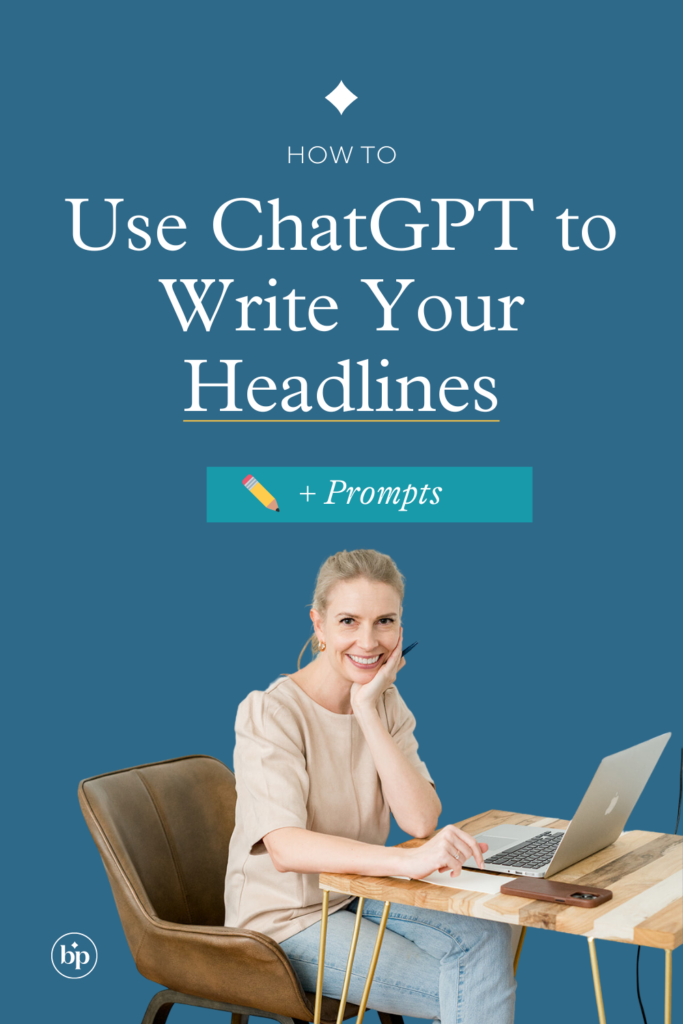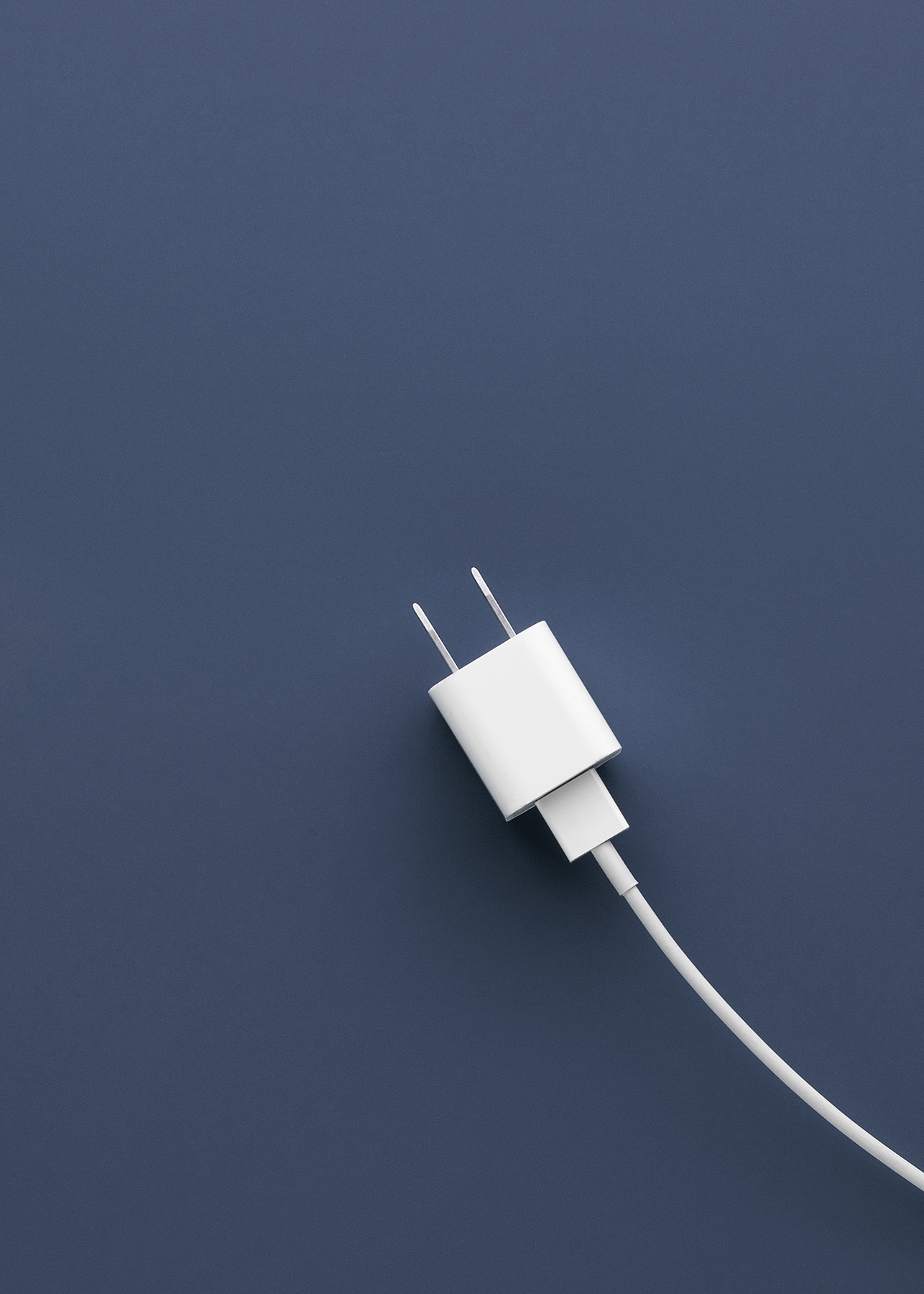Ready or not, the AI Copy Bots are here to stay. But if you’re anything like me (a wait-and-see adopter) you’re hesitant to add another to-do to the list unless it can prove some sure-fire ROI. If you’re looking for a super simple way to test the ChatGPT waters to generate compelling copywriting you can put to use—and test— immediately, look no further than your website headlines and subheads.
CHECK THESE STATS 👁👁: According to studies performed using eye-scanning software, the average website visitor only reads 20% of the content on your page. Another study found that the headline is the first thing that 80% of visitors read before deciding whether to stay or leave a page. Having a compelling headline is crucial to not only capture readers’ attention but also to improve engagement, bounce rates, and conversions on your website.
But writing headlines is so much harder than it sounds. These bite-sized copy elements have to pack a punch while remaining relatively short. And there are a hundred different angles you can take when writing a headline. This is exactly why calling up your copywriting sidekick, ChatGPT, can make the job easier.

So, how do you write website headlines using ChatGPT without sounding like a bot wrote them? What makes a “good” or “bad” headline? And are there any sure-fire prompts and headline formulas you can use with ChatGPT to quickly churn out a smorgasbord of compelling headlines and subheadlines to choose from? Read on…
What makes a headline good or bad?
Before diving straight into the bot’s arms, you need to hone your editing and reasoning skills so you know which ChatGPT-generated headlines are good or bad, and how to fix the bad ones (or get the bot to do it for you. 😉 ) The key elements of a successful headline include relevance, clarity, and emotional appeal. Put them all together and you’ve got the starter ingredients for a great headline.
Relevance
Your headline should accurately reflect the page’s content and be specific enough to provide readers with a clear idea of what they can expect to find as they read on.
Clarity
Even though you’re trying to create something that sticks in your reader’s mind, the #1 rule of copywriting is still, clear over clever. The point you’re trying to make should be obvious and you should avoid complex or technical jargon that may confuse your readers. Additionally, your headlines should convey one idea at a time.
Emotion
Emotional language doesn’t mean you’re trying to make your reader melt into a puddle of tears. A great headline taps into your reader’s desires, and fears, and should create a sense of urgency or curiosity that encourages them to act. (Ex: click, buy, subscribe, call, etc.) Stick this feather in your cap for later so you can ask ChatGPT to rewrite its suggestions to evoke more humor, fear, curiosity, or empathy.
Website headlines, but make it SEO
Yes, your headlines are the optimal place to insert your business’ keywords, but it’s more than that. Get nerdy with me for a second because I want to touch on why headlines are important for your SEO and what font hierarchy has to do with it.
When you are designing your website you should have at least an:
H1 headline
H2 headline
…and Paragraph text settings.
I also vouch for an H3 if you’re using “eyebrow headers” (the small headers that sit on top of the main headline.)
…and some sort of a handwritten H4 font as well, but keep it simple to start.
Header styles aren’t only about creating a visual hierarchy (which, btw, improves readability, engagement and conversions). Header tags also get indexed by search engines and are used to determine the keyword topic and relevance of your page.
If you want to see what your text looks like to Google, pop your URL into www.browseo.net and be prepared to be amazed. I guarantee you’re going to want to take another look at your SEO for Copywriting keyword strategy and pop back into your design panel and make some headline adjustments.
Common mistakes to avoid when writing your headlines
Lacking specificity
Headlines that are vague are forgettable. The best headlines sound like a problem/desire/fear pulled straight out of your reader’s mind. They use specific imagery or give a specific example.
For example:
- Vague Headline: Nutritional counseling by dietitians.
- Specific Headline: Heal your relationship with food without pretending you like kale.
Using kale as the example makes it specific. Even the word “Heal” is a specific choice because we’re not “receiving” counseling, or doing a vague thing, we’re healing, which feels positive and gentle. The second, more specific headline also uses humor to squash the fear that I will have to start eating something I dislike.
To help you find those voice-of-customer copy pulls, grab my free resource the Audience Research Checklist, then read How To Create An Engaging Audience Survey (+13 Example Questions) and pop your research into the Audience Persona & Brand Messaging Workbook. (Only $35!)
Lacking emotional appeal
We are driven by unconscious urges, the biggest of which is emotion. A headline that lacks emotional appeal sounds dull. Most people will diagnose their copy as lacking “personality” but what you’re actually missing is “the hook”. The hook is the critical reason or feeling tugging at their insides that makes them want what you’ve got to offer. It’s the “So, what?” I teach my students inside the Copywriting Cohort Course. The hook piques your reader’s curiosity, creates urgency, and makes your reader want to learn more about your product, service, or promise.
We buy with our emotions and justify with logic.
Without an emotional hook your readers are unlikely to be compelled to scroll further down the page, much less remember what they just read.
Not actionable
Your headline isn’t your CTA (call-to-action) button but it should still feel like a rallying cry. The easiest way to make your headlines incite action is to begin with a verb like this: Transform Your Homepage Into a Workhorse With A Waitlist.
ChatGPT is your copywriting sidekick…but it’s not perfect
In case you’re not familiar, ChatGPT is an artificial intelligence program that uses deep learning techniques to understand natural language and generate human-like responses to text-based prompts. The use cases are many, but this blog post will focus on how to prompt ChatGPT and use popular Headline Formulas to generate headlines you can use throughout your website.
The most important thing to remember about ChatGPT is everything it generates is an extraction of existing information that lives somewhere on the interwebs. In other words, nothing it spits out is an original idea. But lest we get on our high horses about originality, remember that your audience doesn’t *just* buy products and services, they buy you. Your perspective, your approach, and your personality. And that’s the part that ChatGPT can’t reproduce. (Yet…)
An original idea. That can’t be too hard. The library must be full of them.
— Stephen Fry
Use ChatGPT as one of the many tools in your copywriting toolkit to:
- Break through writer’s block
- Save time coming up with ideas or compiling information
- Find different ways to express an idea
- Find common themes in survey results and customer data
- Double-check you’ve addressed all the possible common and uncommon problems/desires/fears etc.
How to use ChatGPT to write compelling website headlines
You could go in cold and start asking headline questions, but the goal is to generate copy that is as relevant and specific to your business as possible. You’ll need to give the bot a little context and a little coaching.
If you were to ask “Write 10 compelling headlines for a website that sells an online course for moms who want to create memorable family videos with their iPhone” you won’t generate headlines that home in on your client’s specific desires, fears, and objections.
Ask generic questions, and you’ll get generic answers.
Ask specific questions, and you’ll get specific answers.
STEP 1: Start by seeding ChatGPT with information about your business
Prompt:
Analyze the following text and tell me what this business is and who it’s for. Text to analyze: [PASTE YOUR HOMEPAGE COPY OR MESSAGING FROM YOUR COPY BANK THAT DESCRIBES YOUR ELEVATOR PITCH OR 1-LINER, YOUR SERVICES/PRODUCTS, AND YOUR BENEFITS/UVP/FEATURES.]
Follow-up prompt:
Who could be a good client for these business services? Please describe in detail and give real-world examples.
Follow-up prompt:
What could happen if this ideal client uses these services? Please describe in detail and give real-world examples.
Follow-up prompt:
What could happen if the ideal client does not use these services? Please describe in detail and give real-world examples.
Follow-up prompt:
What objections might this ideal client have that make them hesitant to hire someone to perform these services?
Follow-up prompt:
What are some common and uncommon problems this ideal client experiences when it comes to their [SERVICE YOU PROVIDE]?
Follow-up prompt:
What are the challenges that prevent this ideal client from solving those problems on their own? Be specific, detailed, vivid, unique, and uncommon, and give up to 5 examples.
Follow-up prompt:
How can this ideal client be convinced it is worth their time and money to hire someone to help them with their [SERVICE YOU PROVIDE]? Please include a relevant statistic or anecdote to further support this.
STEP 2: Prompt ChatGPT to write a headline using a specific headline formula (+ my 3 favorite BP formula examples)
Yes, you can just ask it to “Write 10 compelling headlines for…” but when you make the bot play around with different formulas you’ll start to get “sticky” headlines that are memorable.
Prompt #1: The Obstacles, Schmobstacles Formula #13 in the Headline Hero Formula Lab
Write a website homepage headline knowing what you know about this ideal client using this formula: [Desirable outcome] for [market segment] without [barrier or obstacle that gets in their way].
Follow-up prompt:
Rewrite that to sound more conversational.
Follow-up prompt:
Great! Rewrite that to include the keywords [keyword #1] and/or [keyword #2]
Prompt #2: The WYSIWYG (What You See Is What You Get) #48 in the Headline Hero Formula Lab
Write a website homepage headline knowing what you know about this ideal client using this formula: The [adjective] way for you to [desired outcome] so you can stop [pain point] and start [benefit].
Follow-up prompt:
Can you rewrite that to be no more than 20 words?
Follow-up prompt:
Can you rewrite that to include some alliteration?
Prompt #3: The Paint The Picture Formula #17 in the Headline Hero Formula Lab
Write a website homepage headline knowing what you know about this ideal client using this formula: Change/Transform/Turn [thing they have] into [thing they want].
Follow-up prompt:
Can you rewrite that to sound more empathetic?
“REWRITE THAT…” PRO TIPS:
Adjectives are your friend. Go fill out your Brand Voice Chart, Define Your Brand Personality, and stick your brand words and descriptors (like voice and tone) into your Copy Bank or brand guidelines. Read 100+ Power Words To Boost Conversions and download the swipe file so you can quickly identify and prompt the bot to “Rewrite that in a more conversational/witty/self-deprecating/confident, etc. tone” or “Rewrite those to convey luxury/ease/high-value” or “Rewrite that in a tone that would appeal to millennials/Vogue readers/funny like a McSweeney’s article.”
Can ChatGPT write compelling website subheadlines?
I was skeptical of whether or not ChatGPT would understand the nuances between a headline and a subheadline, and I was happily surprised that it did…mostly. They still needed some tweaking. Let’s put our pencil’s down for a sec and make sure we’re on the same page about the purpose of a good subheadline, too.
Subheadlines are a boon to the text scanners in the room! (All of us, at some point.) Subheadlines, also known as cross-heads, subheadings, or sub-headers, play an important role in website copywriting for several reasons:
Improve readability
Subheadlines break up the written content into smaller, more manageable sections, making it easier for your readers to scan and digest the information on the page. We’ve all been faced with an overwhelming wall of text and the inherent desire to give up and click away. Subheadlines help to organize the content and make it more visually appealing, while still providing the same amount of original information.
Enhance comprehension
Subheadlines can provide additional context and information about the content that follows, helping readers understand the main points of the paragraph to follow. When you’ve got a lot to say, subheadlines allow you to sum up the TL; DR. And yes, the goal of a headline is to compel your readers to snap to attention and read every word on the page, but realistically your job is to reach as many people on the page as possible, no matter their reading style/attention-span. So throw them a bone, and use subheadlines.
Boost SEO
Just like primary headlines, subheadlines can play a role in improving SEO by providing additional opportunities to include relevant keywords and phrases in your copy, thus increasing your chances of ranking higher in search results.
Encourage engagement
Subheadlines can also be used to generate curiosity or interest in the copy that follows. They can distill information in a personality-infused way, like an aside, or “a.k.a.” copy moment. By crafting engaging and descriptive subheadings, readers will feel entertained and continue reading and engaging with your copy.
How to prompt ChatGPT to write subheadlines (+ examples)
If you’ve seeded the bot properly (see prompts above) then the bot should have enough context to understand the problems/benefits/audience/desires we’re trying to address. But because subheadlines expand on what was said in the headline, you’ll get a much better output if you ask for a headline first and then prompt it to produce the subheadline immediately afterward.
Prompt:
Write a headline for the ideal client using this formula: The [adjective] way for you to [desired outcome] so you can stop [pain point] and start [benefit].
Followup prompt:
Now write a subheadline.
Here’s what that looked like after I seeded the bot with Big Picture’s info and asked it to write my headline and subheadline:

Not bad! It needs editing (too many ideas in one sentence) so I followed that up by asking it to make it shorter and got this:

The result is snappy and concise. I might even break those sentences apart and make “Let us handle the words” the subhead altogether.
Does using ChatGPT for copywriting live up to the hype?
When viewed as a tool, ChatGPT is pretty darn cool, but it’s certainly not replacing copywriters’ jobs yet. It struggles with conveying authentic emotions and I could not for the life of me make ChatGPT funny in a non-Dad-jokes way. (Although, I did enjoy this sick burn it produced, “Because let’s face it, you’re better at running your business than writing your own copy.”)
The content output is still very much “intern-quality” and requires you to put on your Editor’s Hat, but it can jump-start your copywriting and help you brainstorm different ways to write your headlines and subheadlines pretty effectively.
Want more help with your headlines?
Swipe 50 headline formulas for websites, courses, services, and product descriptions and more.
WHAT’S INSIDE:
- 50 headline formulas + EXAMPLES for websites, courses, services, and digital products.
- Headline Formulas Lab Worksheets
- Goal Matching Headline Organization:
- WYSIWYG (Wizzy Wig – A.K.A.- What You See Is What You Get)
- Value Prop It Like It’s Hot
- Swing Into Action
- Make It Easy Like Sunday Morning
- Pique Curiosity
- Paint The Picture
- Objection, Your Honor!
- Obstacles, Schmobstacles
- Question For You…
- Social Proof Is Truth
- The Rally Cry
If you find my articles & free resources helpful…
The BP Resource Library started as a way to offer brand strategy and copywriting education to creatives and entrepreneurs with champagne tastes but a Pellegrino budget.
If I’m helping you make more sense of this whole “writing for your biz” thing, please consider expressing your appreciation for the research, writing, and design that goes into each and every post and library freebie.
Donate to my espresso fund
PIN TO SAVE FOR LATER


